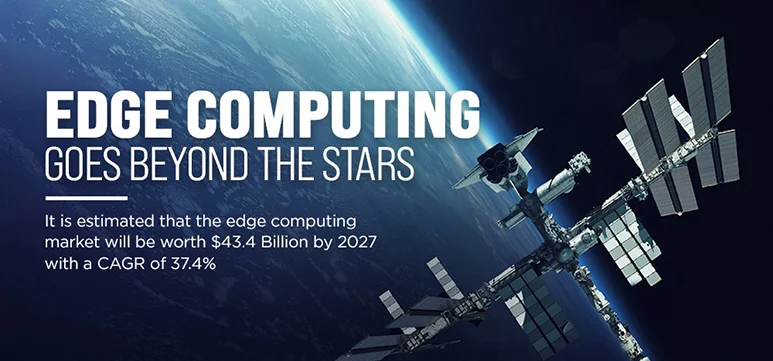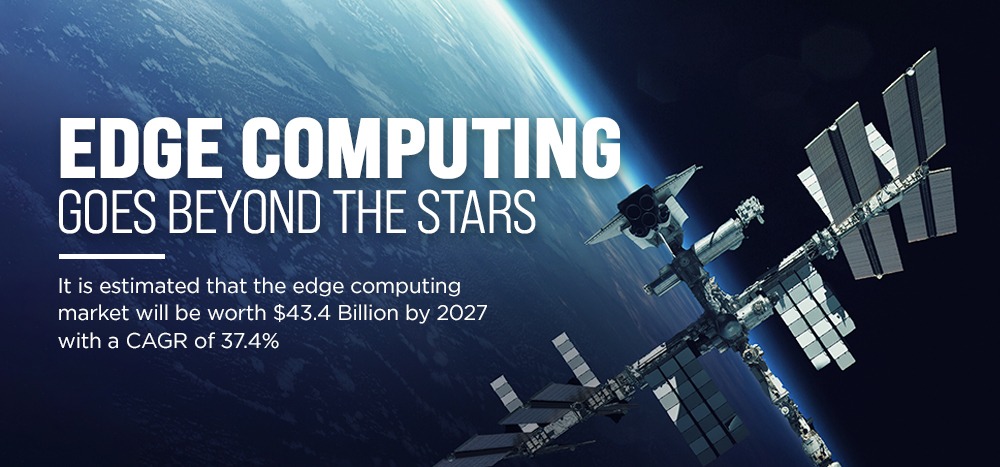We discuss the following topics in this blog:
- Major Architectural paving the way for Edge Computing
- Ultra-low Latency, Larger bandwidth, Privacy, Security and the Cost
In addition to these topics, we shall also be answering the following FAQs:
- What is a Data Centre?
- What is Cloud Computing?

Contents
Overview
Today we are going to talk about something that a lot of us know a little bit about, and most of us want to know a lot more about. From Autonomous Vehicles to 5G Applications to digitizing the International Space Station, this technology is going places. The buzzword is Edge Computing, I am sure you have heard the term and if you are reading this blog on your kindle or laptop or mobile phone or whatever is your reading device of choice, you are getting it all from a server that is not too far away. The servers are sending the data close to you, they are sending the stuff close to you, they are sending the things that you need for your internet experience close to the edge. That’s the basic understanding. But how about we dig deep into it.
Why Should We Care About Edge Computing in the First Place?
Major Architectural shift has paved the way for Edge Computing
Back in the early 60s, we had these big mainframe computers right. It was about connecting your computers using dumb terminals, much like a standard centralized model. Next, in the 80s everything was upside down, we moved into client-server models, the era of AS400s and Oracle servers. This was also the era when people were first introduced to personal computing.
Then came the 2000s, the era of cloud computing. It was a large-scale model across shared infrastructure, but it was centralized, something that revolutionized the IT and technology landscape. This time most of us had personal computers but we all started to access centralized services like Dropbox, Office 365, Slack, and Gmail. Even today devices like Amazon Echo, Google Chromecast, and the Apple TV are powered by content and intelligence that’s in the cloud.
It won’t be wrong to say that we rely on infrastructure, hosting, machine learning, and compute power of a very select few cloud providers such as Amazon, Microsoft, Google, and IBM. As everything that could be centralized has been already centralized, it’s time to harness the opportunities that the Edge can offer. Finally, when emerging technologies like IoT, M2M, 5G, and AI are making their way into our daily lives, we are realizing that everything cannot and must not run on the cloud. So now, the cloud moves to the edge, the computing moves to the edge.
We are now at a stage where we have lived the entire technology cycle, from centralized to distributed to combined. As a matter of fact, in 3 years, 45 % of IoT devices will be stored, processed, analyzed, and acted upon close to, or at the edge of the network and over 6 billion devices will be connected to Edge Computing. It is estimated that the edge computing market will be worth $43.4 Billion by 2027 with a CAGR of 37.4%.
Edge Computing is disruptive and fundamentally going to change everything
Before we deep dive, first, let’s get the foundation right. Edge is basically a physical location where the users, the cellphones, the sensors, etc. establish connections. Edge Computing, on the other hand, is basically computing happening at the edge, basically a topology element. Computing can also happen at the cloud or at a data center, but in this case, it’s happening at the edge. Imagine it as the cloud coming close to you.
What’s Going to Actually Change?
- Ultra-low Latency
Let’s say if user A needs to connect to a user B that’s half a globe away before it can do anything, user A perceives this delay in service as latency. Being closer to the actual user Edge Computing ensures that the data does not have to be sent back and forth to the cloud or a data centre. All the data can be generated, processed, stored, and computed at the edge. This makes it a perfect choice for low latency applications like Industrial IoT, 5G, Self-driving cars, and much more. For eg there is a gas pump in a refinery that is monitoring pressure that needs to be shut quickly without human intervention will require ultra-low latency. In human application scale-like voice assistance it’s in tens of milliseconds and for machine scale-like Autonomous Vehicles it’s in terms in microseconds or even sometimes in nanoseconds.
2. Larger Bandwidth
Instead of sending lots of data back and forth to the cloud for processing, Edge gives the capability of doing all the heavy lifting. For eg With technologies like IoT becoming mainstream, we will have lots of data being transferred between multiple devices and the server (all of this happening at lightning speeds). Edge Computing plays a vital role in making this happen.
3. Privacy, Security, and the Cost
As data gets decentralized at multiple nodes, it ensures compliance with data sovereignty and other regulations. A perfect example of this would be your android device, it stores your fingerprint on the device which then authenticates and manages end-to-end security rather than storing the biometric data on a cloud. Edge Computing is an auto tool for security. Apart from this when it comes to cost-effectiveness, Edge offers the edge by significantly bringing down the backhaul cost by reducing the amount of traffic that needs to be transported to centralized data centres.
Finally, let’s explore how Edge Computing will be an enabler for the 5G Technology
With 5G coming in, it is changing the edge dramatically. Access created edge will have base stations, RAN for LTE/Edge, Radio N/W Controller, CMTS, PON OLT, Hotspots, Data centre’s, small cells, Routers and switches, Wifi Access points.
Or maybe let’s just discuss this sometime later – you can now go back to your binge-watching, something which is again powered by Edge Computing – Another chapter, Another day Voila!
FAQs
What is a Data Centre?
A data centre, sometimes referred to as a server farm, is a centralized physical location housing compute resources (high-end servers), storage (SSD, HDD, Flash, Optical), and networking equipment (routers, switches, firewalls, etc.) for collecting, storing, processing, distributing and allowing access to large amounts of data. Apart from the IT equipment data center also houses environment controls (airflow, humidity & temperature sensors), server racks, power supplies (backup systems, generators), and cabling systems (ethernet, copper, optical fiber). Initially, data centers were introduced to manage the large influx of service requests and store user-generated data. In contrast, it has now evolved to adopt technologies such as virtualization, cloud computing, mobile, Internet of Things (IoT) applications, machine learning, artificial intelligence (AI), and big data analytics.
There are four main types of data centers:
a) Enterprise data centers – Built, owned, and managed by a company for particular use-cases for their target user set. They are usually built on-site but can also be built away from the company premise.
b) Managed services data centers – Deployed, managed, and monitored by a third-party datacentre service provider for a company. The features and functionality can be accessed by the company using a managed service platform (MSP)
c) Colocation data centers – Consist of one data center owner selling space, power, and cooling to multiple enterprises and hyperscale customers in a specific location. The company focuses entirely on running the compute, storage, and networking equipment while the data centre service provider takes care of the space, power, cooling, security, and IT racks.
d) Cloud data centers- An off-site data centre provider such as Amazon Web Services (AWS), Microsoft Azure, IBM Cloud that stores the data of various enterprises. The data is fragmented and stored at various locations across the internet (i.e. datacentres across the world). This offers enhanced security, scalability, management, reliability, customization, and cost-effectiveness.
What is Cloud Computing?
Cloud computing is a paradigm that allows On-demand network access to shared computing resources. A model for managing, storing and processing data online via the internet. The three major characteristics of cloud computing are On-Demand Service, Network Access, and shared resources.
There are three major delivery models of cloud computing, namely Software as a Service (for end-users), Platform as a service (for developers), and Infrastructure as a service (for system administrators).
1) Software as a Service or SaaS is a new method of delivering software applications. Instead of accessing the software from local servers (a powerful computer system), it uses the internet to access the software applications. To be considered SaaS, the software needs to be delivered either through a web interface or a mobile application. E.g., Microsoft 365, Salesforce CRM, Google suite apps, etc.
2) Platform as a service or PaaS is made up of a programing language execution environment, an operating system, a web server, and a database. The service enables users to build, run and compile the programs without an underlying infrastructure. Apart from the data and application resources, everything else is managed by the service-providing vendor, e.g., AWS, Azure, Google App engine, etc.
3) Infrastructure as a service or IaaS is a service that offers computing architecture & infrastructure and computing resources like data storage, virtualization, servers & networking in a virtual environment so that multiple users can access them. Apart from Applications, Data, Runtime, and Middleware, everything else is managed by the service-providing vendor. For, e.g., Cisco Metacloud, Rackspace, Amazon EC2, etc.
Uses of Cloud Computing include: Developing cloud-native applications on the go; Secure, Efficient & Reliable storage capability; Audio and Video streaming; On-Demand Software, Platforms & Infrastructure; Online Test and Build ecosystem support; Data Analytics; Embedded Intelligence; Scalability & Speed.
















1 Comment
Vijay
February 25, 2021You definitely enhanced my knowledge. Look forward to your next article. Cheers.